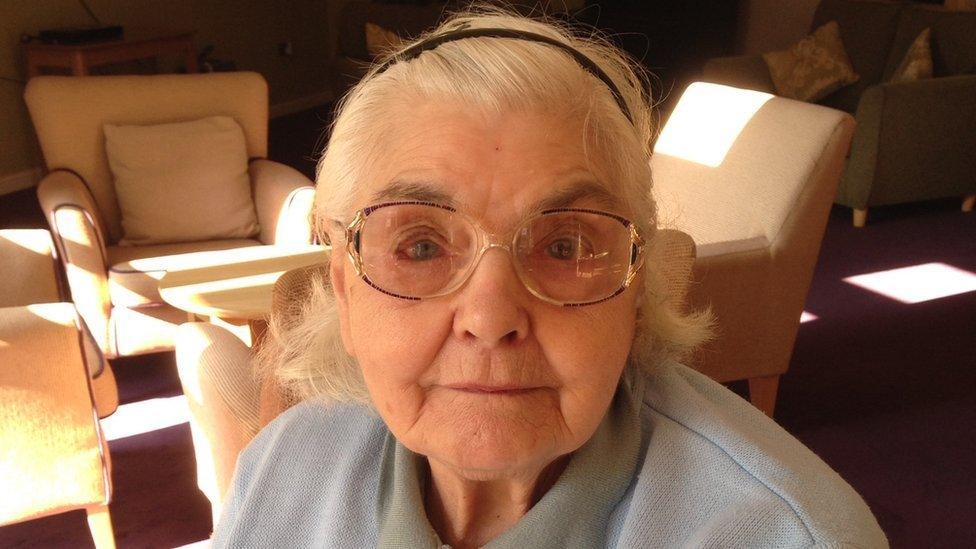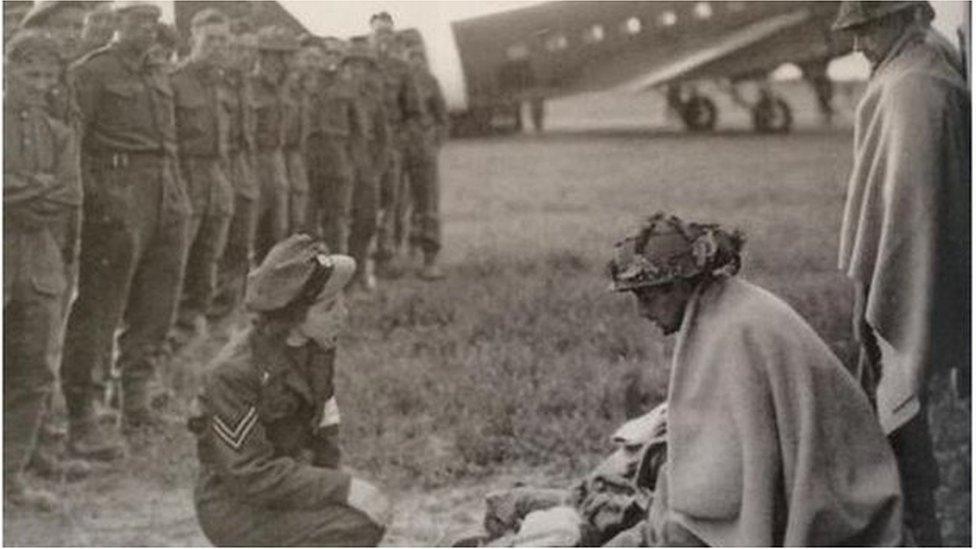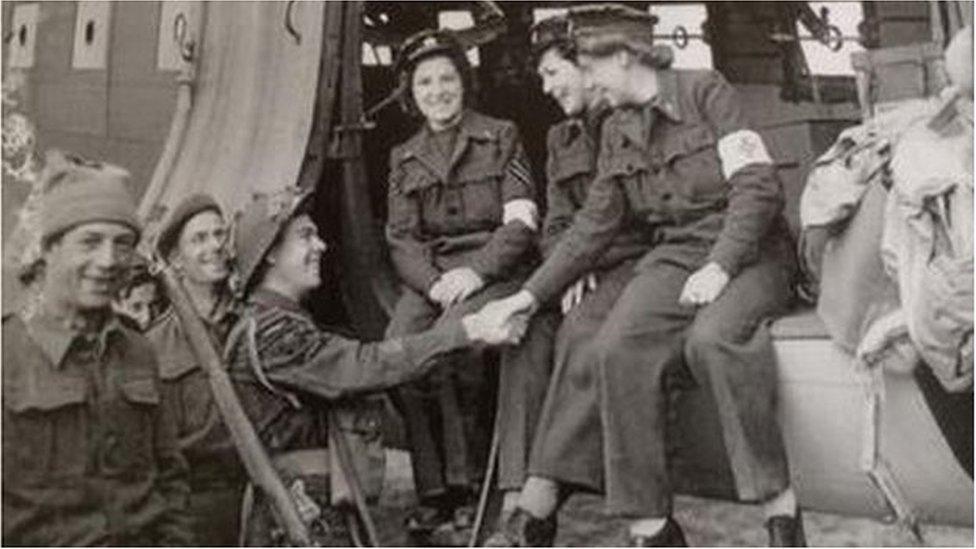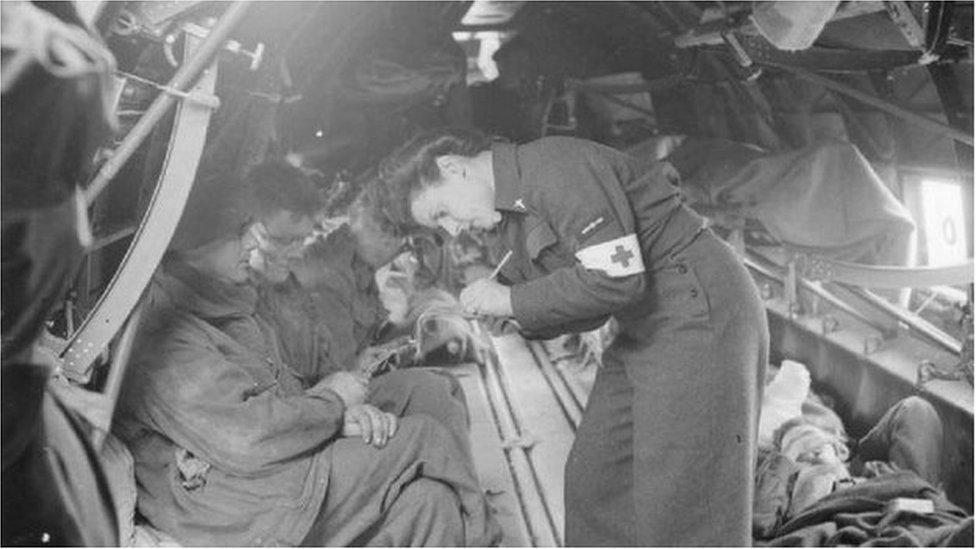Lilian West: The last of the Flying Nightingales
- Published

The nurses were civilian volunteers who risked their lives
Lilian West believes she is the last of the "Flying Nightingales" - the air ambulance nurses of World War Two who risked their lives to bring back almost 100,000 wounded soldiers from the European mainland to British hospitals. During her four years with the Women's Auxiliary Air Force, Mrs West witnessed the full horrors of the war.
It was not until the 1980s that Mrs West, now 91, felt able to tell her two children what she did during the war.
"I didn't tell them anything," she said. "I never talked about it much.
"We didn't really - our generation. It was just so awful - the things we saw."
Mrs West, from Cardiff, believes she is the last surviving air ambulance nurse - who were affectionately known as the Flying Nightingales.
As a 17-year-old from Cardiff, whose father had been wounded by shrapnel in World War One, the young Mrs West considered it her duty to sign up to be a nursing orderly in the Women's Auxiliary Air Force (WAAF).
"I wanted to do it," she said, simply.
'Civilians in uniform'
In 1941, she spent just six weeks training in Exeter.
"All of the flying nightingales were volunteers," said Kara Holliday, a former RAF air traffic controller who has researched the history of the nurses.
"They weren't recognised as being RAF nurses because they would have had to hold the rank of officer.

Lilian West spent just six weeks training to be an air ambulance nurse
"Their rank wasn't acknowledged, they weren't given medals. They were civilians in uniform."
Mrs West had to learn how to use oxygen, administer injections and deal with war wounds such as broken bones, severed limbs, burns and head injuries.
The nurses were then moved to an airfield in Leicester to learn about how to adapt to flying at altitude and landing in an aircraft.
The 200 nurses of the RAF's Air Ambulance Unit, which flew under 46 Group Transport Command, were based at three airfields: Down Ampney, in Gloucestershire, Blakehill Farm, in Wiltshire and Broadwell, in Oxfordshire.
At Down Ampney the starts were early, the weather often poor.
The blue-clad figures would run across the airfield carrying their first-aid panniers, a small bottle of oxygen and their parachutes.

A historian who has studied the Flying Nightingales believes not one soldier died en route
"If you were walking through a few puddles you were lucky," said Mrs West.
"They often had to lay down planks of wood for us to walk over, it was so muddy."
The women would then each board an RAF Dakota, manned by four crew, and set off on their hour-long flight over the Channel to France.
Mrs West said the windows in the back of the plane, where she was sitting, were covered over so she could only imagine the white cliffs of Dover passing underneath, the violence of the war raging outside.
The flight across the Channel was far from smooth. The craft would shake from side to side and bounce up and down.
"Of course we were afraid," Mrs West said. "Your heart was in your mouth. You never knew when you were going to get hit by the shots that were flying all around you.
"We couldn't wave the Red Cross flag because if the Germans had seen it they would have shot us down straight away. All the planes were camouflaged."
The outbound flights carried supplies to the Allied troops fighting in France, Belgium, Holland and Germany.

The outbound flights carried supplies while the homebound ones carried patients
The homeward flights, with casualties aboard, were classified as air ambulances.
"We would fly over with medical supplies and drop them off," Mrs West said. "Then the wounded would get on and we would take them back to England."
The wounded soldiers had been sent to airfields on the French coast and were often waiting for the Dakota to pick them up and take them back to England.
"We had about 18 stretchers in the planes, plus the walking wounded," said Mrs West. "The nurses were there to keep an eye on the patients.
"We had to give them drinks and put them at their ease. All of their [wounded] limbs were encased in a saline solution and plaster until they could be treated."
Although the nurses were given parachutes, they were told they were only allowed to use them on the flight out.
On the way back, their orders were to stay with the plane to treat any survivors and their parachutes were locked away.
"Thank God I was never shot down," Mrs West said. She is only aware of one of her colleagues who was - a young woman called Margaret who died in action with a Canadian squadron.
Even today, she feels traumatised by the cases she dealt with.
"The things I saw, I couldn't talk about. I was on duty one day and apparently a rocket had backfired on a Navy boat, taking the top off an officer's head. I had to take him to the Radcliffe Infirmary in Oxford."
She also remembers bringing an African-American soldier all the way back from Belgium, only to have him turned away at a British hospital because of the colour of his skin.
"I still feel upset about that," she said.
Some of her colleagues helped treat the victims of the concentration camp at Bergen-Belsen. The Dakotas were used to fly some of the orphaned child survivors to families in Switzerland who had volunteered to care for them.

The nurses had to care for 18 patients on stretchers, plus the walking wounded
The nurses earned 8p a day for risking their lives.
But despite the harrowing experiences they endured, their efforts helped ensure soldiers got the treatment they needed.
It is estimated 100,000 wounded soldiers were rescued from France.
"You can imagine the work was exhausting," said Miss Holliday.
"On the way back, there wasn't anywhere for these air ambulance nurses to sit, so they had to stand the whole time.
"There's not much space to move about and they had to tend to these 24 wounded men. It would have been constant."
Yet, she believes, not one soldier died en route.
Mrs West remained with the service for five years.
After the war, she gave up nursing to raise a family.
Almost all of the air ambulance nurses did give up their careers when they married, Miss Holliday said.
Some suffered terribly in the aftermath of their experiences, traumatised by the terrible injuries they had seen.
But, in Mrs West's family, nursing has passed down the generations - her daughter is a care manager, while her granddaughter is a community nurse.
"I suppose they're practical, like I am," she said. "My doctor said to me, 'Why don't you slow down?' But I don't seem to be able to."
In 2008 the seven nurses who were then still living were presented with lifetime achievement awards by the Duchess of Cornwall, external.
But otherwise, their achievements are barely known about.
Today, Mrs West believes she is the last living Nightingale.
She returned to Down Ampney in September for the 70th anniversary of Operation Market Garden.
At the end of what used to be the runway there is a memorial honouring those who took off in Dakotas from the small Cotswold airfield and flew into warzones in Normandy, Arnhem and the Rhine.
There, Mrs West bent to lay a wreath.
"It was something I did for all our girls," she said.